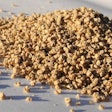In 2013, the Brazilian government misjudged the ability of initiatives, such as fuel-price freezes and tax exemptions, to spark consumption, as well as to strengthen the country's productivity and international competitiveness. Consecutive years of setbacks have weakened the Brazilian central bank's economic activity index, or IBC-Br, and resulted in only a 2.3 percent rise in the country's GDP in 2013. The weakening of economic indices has affected the performance of many supply chains, including agriculture, which slipped in the last quarter of 2013.
In contrast to the economic recovery in the United States, encouraging signs from the key players in the European Union, and a reasonable performance by the economies of Brazil's neighbors, the forecast deterioration in the domestic economy is being verified each time official statistics are released.
In 2013, Brazil's 5.9 percent inflation rate was above its target of 4.5 percent. Additionally, with volatile exchange rates and the devaluation of domestic currency contrasting with the U.S. tightening of monetary policy, the Effective Exchange Rate (EER/BIS) has has still further to fall. This change in the exchange rate favors companies with revenue in dollars and those with much of their production exported.
The international situation continues to be negatively impacted by Argentina's protectionist stance against Brazilian goods, the concentration of exports on commodities, and the withdrawal of dollars from the country by some investors with a poor view of Brazil.
Forecasts by species
The demand for complete feed is estimated at 64.6 million metric tons, which is almost the same that recorded in 2012. Overall, the projections account for almost 67 million metric tons, which is comprised of 64.4 million metric tons of complete feed and 2.2 million metric tons of mineral supplements. The estimates below were based on forecasts from a number of industry associations and allow for a certain degree of optimism.
Broiler feed: Although feed costs eased in 2013, the scarce supply of chicks, decreased poultry production by 1.5 percent; 30.3 million MT of feed were consumed. In response to forecasted production, as well as exports during 2014, demand for feed is estimated at 31.3 million MT, an increase of 3.4 percent.
Layer feed: Conversely, the production of laying hen feed grew by 5.1 percent and reached 5.5 million metric tons in 2013. However, an oversupply of eggs decreased the farm price in the last quarter and forced reduced activity. The demand for feed in 2014 is set to grow by nearly 4 percent to reach 5.7 million metric tons.
Beef cattle feed: The demand for cattle feed reached 2.52 million metric tons in 2013, a setback of 1.9 percent. The availability of steers and calves valued for much of the year determined an exchange ratio short of expectation, which discouraged replacement. The Brazilian feed industry is expected to produce 2.59 million metric tons in 2014, a growth rate of approximately 3 percent.
Dairy cattle feed: In 2013, Brazil manufactured 5 million metric tons of dairy cattle feed, an increase of 4.1 percent. Producers, who spent less on nutrition costs because the price of corn and soybean meal stabilized, sustained the demand. Growth may be moderate in 2014, with a 3 percent rise and consumption of 5.5 million metric tons of feed.
Swine feed: Due to a scarce piglet supply, lighter finished hogs and the cooling of pork export, the demand for swine feed declined by 1.5 percent (14.9 million metric tons). Estimates suggest 2014 feed production will remain virtually unchanged, i.e. 14.9 million metric tons.
Fish and shrimp: In 2013, the demand for fish and shrimp feed grew nearly 14 percent to reach 740,000 metric tons (661,000 metric tons of feed for fish; 79,000 metric tons of shrimp feed). In 2014, the country is expected to produce more than 840,000 metric tons of fish and shrimp feed.
Pet food: Driven by the emerging middle class, production of dog and cat food grew 5.3 percent, reaching 2.4 million metric tons in 2013. Forecasts suggest the demand may reach almost 2.5 million metric tons, an increase of 5 percent in 2014.






